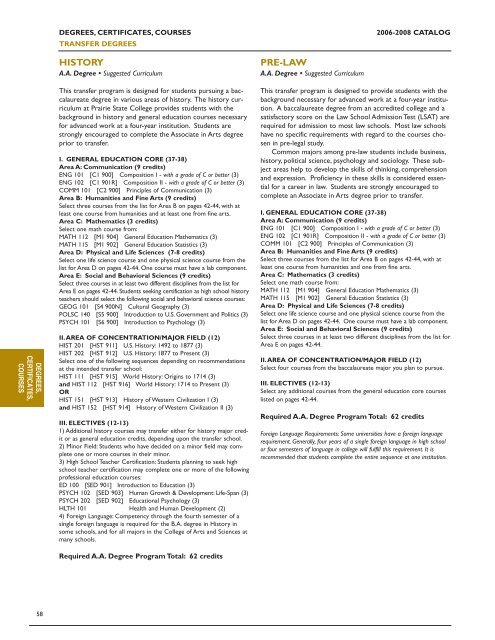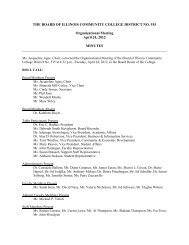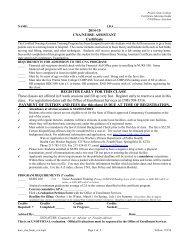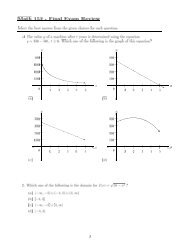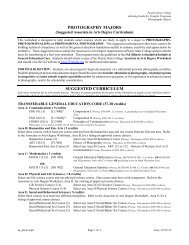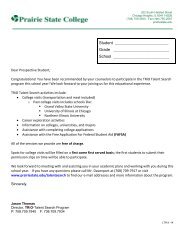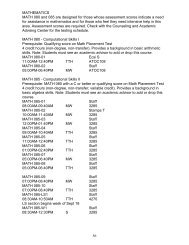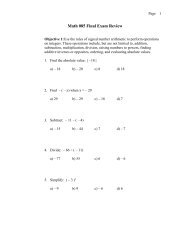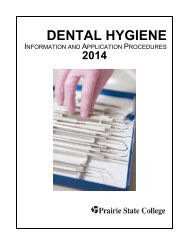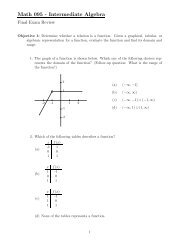catalog - Prairie State College
catalog - Prairie State College
catalog - Prairie State College
- No tags were found...
You also want an ePaper? Increase the reach of your titles
YUMPU automatically turns print PDFs into web optimized ePapers that Google loves.
DEGREES, CERTIFICATES, COURSESTRANSFER DEGREES2006-2008 CATALOGDEGREES,CERTIFICATES,COURSESHISTORYA.A. Degree • Suggested CurriculumThis transfer program is designed for students pursuing a baccalaureatedegree in various areas of history. The history curriculumat <strong>Prairie</strong> <strong>State</strong> <strong>College</strong> provides students with thebackground in history and general education courses necessaryfor advanced work at a four-year institution. Students arestrongly encouraged to complete the Associate in Arts degreeprior to transfer.I. GENERAL EDUCATION CORE (37-38)Area A: Communication (9 credits)ENG 101 [C1 900] Composition I - with a grade of C or better (3)ENG 102 [C1 901R] Composition II - with a grade of C or better (3)COMM 101 [C2 900] Principles of Communication (3)Area B: Humanities and Fine Arts (9 credits)Select three courses from the list for Area B on pages 42-44, with atleast one course from humanities and at least one from fine arts.Area C: Mathematics (3 credits)Select one math course from:MATH 112 [M1 904] General Education Mathematics (3)MATH 115 [M1 902] General Education Statistics (3)Area D: Physical and Life Sciences (7-8 credits)Select one life science course and one physical science course from thelist for Area D on pages 42-44. One course must have a lab component.Area E: Social and Behavioral Sciences (9 credits)Select three courses in at least two different disciplines from the list forArea E on pages 42-44. Students seeking certification as high school historyteachers should select the following social and behavioral science courses:GEOG 101 [S4 900N] Cultural Geography (3)POLSC 140 [S5 900] Introduction to U.S. Government and Politics (3)PSYCH 101 [S6 900] Introduction to Psychology (3)II.AREA OF CONCENTRATION/MAJOR FIELD (12)HIST 201 [HST 911] U.S. History: 1492 to 1877 (3)HIST 202 [HST 912] U.S. History: 1877 to Present (3)Select one of the following sequences depending on recommendationsat the intended transfer school:HIST 111 [HST 915] World History: Origins to 1714 (3)and HIST 112 [HST 916] World History: 1714 to Present (3)ORHIST 151 [HST 913] History of Western Civilization I (3)and HIST 152 [HST 914] History of Western Civilization II (3)III. ELECTIVES (12-13)1) Additional history courses may transfer either for history major creditor as general education credits, depending upon the transfer school.2) Minor Field: Students who have decided on a minor field may completeone or more courses in their minor.3) High School Teacher Certification: Students planning to seek highschool teacher certification may complete one or more of the followingprofessional education courses:ED 100 [SED 901] Introduction to Education (3)PSYCH 102 [SED 903] Human Growth & Development: Life-Span (3)PSYCH 202 [SED 902] Educational Psychology (3)HLTH 101 Health and Human Development (2)4) Foreign Language: Competency through the fourth semester of asingle foreign language is required for the B.A. degree in History insome schools, and for all majors in the <strong>College</strong> of Arts and Sciences atmany schools.Required A.A. Degree Program Total: 62 creditsPRE-LAWA.A. Degree • Suggested CurriculumThis transfer program is designed to provide students with thebackground necessary for advanced work at a four-year institution.A baccalaureate degree from an accredited college and asatisfactory score on the Law School Admission Test (LSAT) arerequired for admission to most law schools. Most law schoolshave no specific requirements with regard to the courses chosenin pre-legal study.Common majors among pre-law students include business,history, political science, psychology and sociology. These subjectareas help to develop the skills of thinking, comprehensionand expression. Proficiency in these skills is considered essentialfor a career in law. Students are strongly encouraged tocomplete an Associate in Arts degree prior to transfer.I. GENERAL EDUCATION CORE (37-38)Area A: Communication (9 credits)ENG 101 [C1 900] Composition I - with a grade of C or better (3)ENG 102 [C1 901R] Composition II - with a grade of C or better (3)COMM 101 [C2 900] Principles of Communication (3)Area B: Humanities and Fine Arts (9 credits)Select three courses from the list for Area B on pages 42-44, with atleast one course from humanities and one from fine arts.Area C: Mathematics (3 credits)Select one math course from:MATH 112 [M1 904] General Education Mathematics (3)MATH 115 [M1 902] General Education Statistics (3)Area D: Physical and Life Sciences (7-8 credits)Select one life science course and one physical science course from thelist for Area D on pages 42-44. One course must have a lab component.Area E: Social and Behavioral Sciences (9 credits)Select three courses in at least two different disciplines from the list forArea E on pages 42-44.II.AREA OF CONCENTRATION/MAJOR FIELD (12)Select four courses from the baccalaureate major you plan to pursue.III. ELECTIVES (12-13)Select any additional courses from the general education core courseslisted on pages 42-44.Required A.A. Degree Program Total: 62 creditsForeign Language Requirements: Some universities have a foreign languagerequirement. Generally, four years of a single foreign language in high schoolor four semesters of language in college will fulfill this requirement. It isrecommended that students complete the entire sequence at one institution.58


